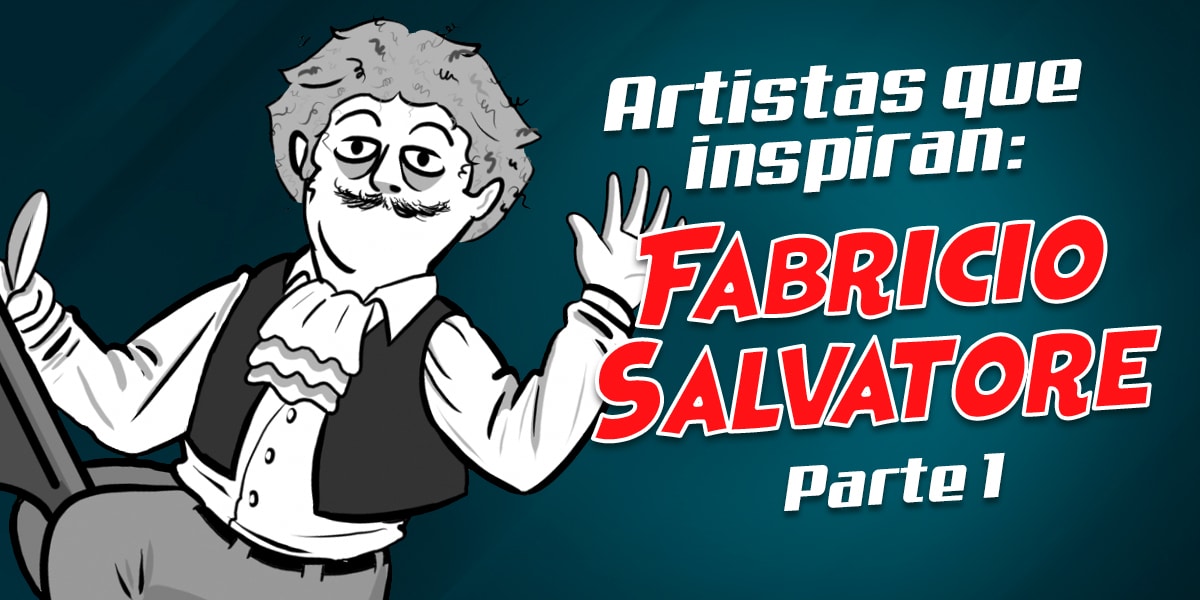Los mejores tips para lograr poses expresivas en tus ilustraciones
¿Alguna vez te has preguntado cómo los grandes artistas logran crear personajes tan vivos y dinámicos en sus ilustraciones? La clave está en dominar el arte de las poses expresivas. En este artículo, te revelaremos los secretos mejor guardados para que tus dibujos cobren vida y transmitan emociones de forma impactante. Desde técnicas inspiradas en la fotografía hasta trucos utilizados por escultores renacentistas, te guiaremos paso a paso para que tus creaciones pasen de ser simples bocetos a auténticas obras maestras llenas de movimiento y expresividad. ¿Estás listo para llevar tus habilidades al siguiente nivel? ¡Sigue leyendo y descubre cómo transformar tus ilustraciones!
El secreto del movimiento: Cómo evitar la rigidez en tus dibujos
La clave para lograr poses expresivas radica en capturar la esencia del movimiento, incluso en posiciones aparentemente estáticas. El cuerpo humano, aun en reposo, posee una dinámica interna que debemos aprender a observar y plasmar en nuestros dibujos. Esta sutileza es lo que diferencia a un personaje que parece “vivo” de uno que se ve rígido y artificial.
Para ilustrar este concepto, comparemos dos obras escultóricas icónicas que nos ofrecen una lección magistral sobre la evolución en la representación del cuerpo humano:
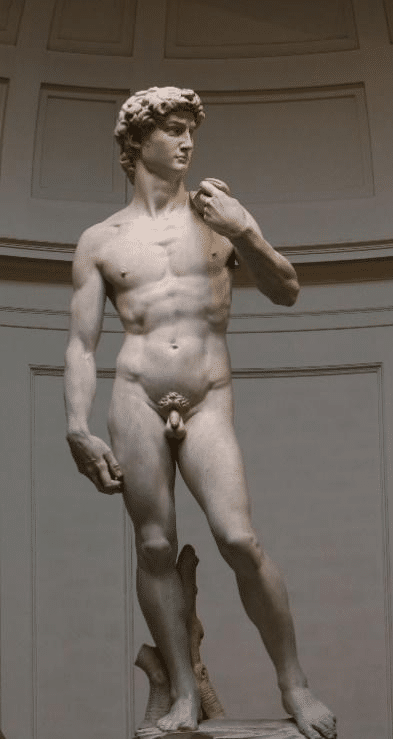
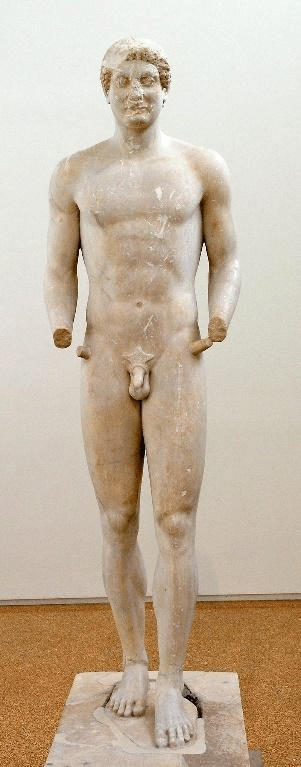
En la primera imagen, observamos el “Kuros de Aristódikos”, una escultura del año 500 a.C. Notarás inmediatamente la postura rígida y tensa, característica del arte griego arcaico. Esta representación, aunque impresionante para su época, carece de la fluidez y naturalidad que buscamos en nuestras ilustraciones modernas.
En contraste, “El David” de Miguel Ángel (1501-1504) nos muestra una revolución en la forma de representar el cuerpo humano. Fíjate en los detalles sutiles pero cruciales:
- La alineación asimétrica de los hombros
- El movimiento suave de los brazos
- La curva sinuosa de la columna vertebral
- La posición natural de la cabeza
- El balance dinámico entre las piernas
Estos elementos, aparentemente simples, son los que otorgan vida y expresividad a la figura. Como ilustradores, nuestro desafío es incorporar estos principios en nuestros dibujos, ¿Quieres llevar tus habilidades de anatomía al siguiente nivel? Explora más aquí y descubre cómo puedes aplicar estos conceptos en tus propias creaciones.
La fotografía como aliada: Capturando la naturalidad en tus poses
La fotografía es una herramienta invaluable para el ilustrador que busca crear poses expresivas y naturales. Sin embargo, no todas las fotografías son igualmente útiles para este propósito. La clave está en seleccionar imágenes que capturen la esencia del movimiento y la espontaneidad humana.
Para lograr esto, es fundamental enfocarse en fotografías de personas reales en situaciones cotidianas, preferiblemente cuando no son conscientes de que están siendo fotografiadas. Estas imágenes nos ofrecen una visión auténtica de cómo el cuerpo humano se mueve y se expresa naturalmente.
Evita utilizar imágenes de modelos publicitarios o fotografías claramente posadas. Aunque estas pueden ser estéticamente agradables, a menudo presentan posturas idealizadas y artificiales que no reflejan el movimiento natural del cuerpo. Nuestro objetivo es capturar la vida real, no una versión estilizada de ella.
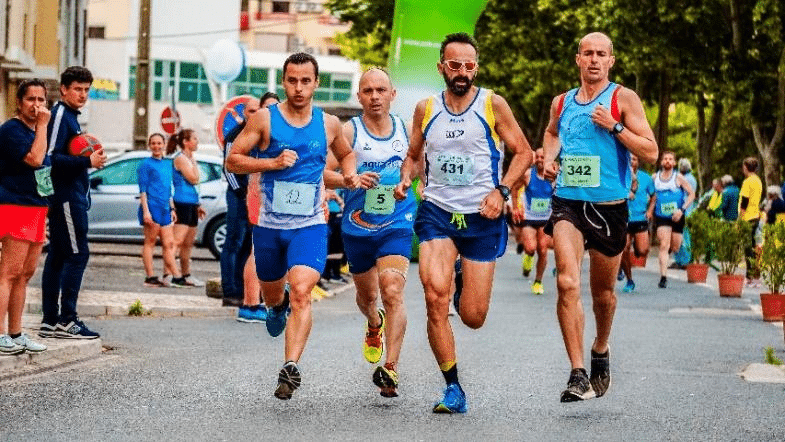
Observa esta imagen de corredores en plena acción. Aquí vemos cuerpos en movimiento, concentrados en su tarea, sin poses artificiales. Fíjate en la variedad de posturas, la tensión en los músculos, la inclinación natural de los cuerpos. Estos son los detalles que dan vida a nuestros dibujos.
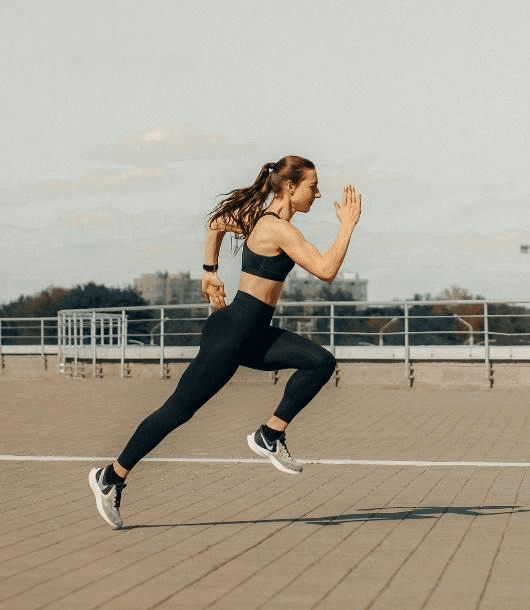
En contraste, esta imagen muestra una pose claramente preparada para una sesión fotográfica. Aunque puede ser visualmente atractiva, carece de la naturalidad y espontaneidad que buscamos para nuestras ilustraciones expresivas.
Al trabajar con referencias fotográficas, pregúntate: ¿Esta pose se ve natural? ¿Puedo imaginar a alguien adoptando esta postura en la vida real? Si la respuesta es no, probablemente no sea la mejor referencia para una pose expresiva y dinámica.
Haz clic aquí para descubrir más sobre cómo utilizar referencias fotográficas efectivamente y mejorar la expresividad de tus personajes. Aprenderás técnicas para analizar y adaptar poses reales a tus ilustraciones, dándoles vida y autenticidad.
El modelo vivo: La herramienta definitiva para dominar las posturas expresivas
Si realmente quieres elevar tu habilidad para crear poses expresivas, no hay sustituto para el dibujo de modelo vivo. Esta práctica ofrece una experiencia incomparable que combina observación aguda, síntesis rápida y comprensión profunda de la anatomía en movimiento.
El dibujo de modelo vivo te desafía a capturar la esencia de una pose en un tiempo limitado, generalmente entre 2 y 10 minutos. Esta restricción temporal te obliga a identificar y plasmar rápidamente los elementos más importantes de la postura, desarrollando tu capacidad de síntesis y tu ojo para los detalles cruciales.
Beneficios del dibujo de modelo vivo:
- Mejora tu comprensión de la anatomía en acción
- Desarrolla tu habilidad para capturar movimiento y expresión
- Entrena tu ojo para identificar las líneas de acción y las formas principales
- Te ayuda a superar los estereotipos y las poses “de memoria”
- Aumenta tu velocidad y confianza al dibujar figuras humanas
Para maximizar los beneficios de esta práctica:
- Varía tus modelos: Trabaja con diferentes cuerpos y tipos físicos para ampliar tu repertorio.
- Experimenta con diferentes duraciones: Alterna entre poses rápidas de 30 segundos y sesiones más largas de 15-20 minutos.
- Enfócate en la línea de acción: Comienza cada dibujo identificando la curva principal que define la pose.
- Practica en espacios públicos: Dibuja personas en cafeterías, parques o transporte público para capturar poses naturales y espontáneas.
- No busques la perfección: El objetivo es capturar la esencia y la energía de la pose, no crear un dibujo acabado.
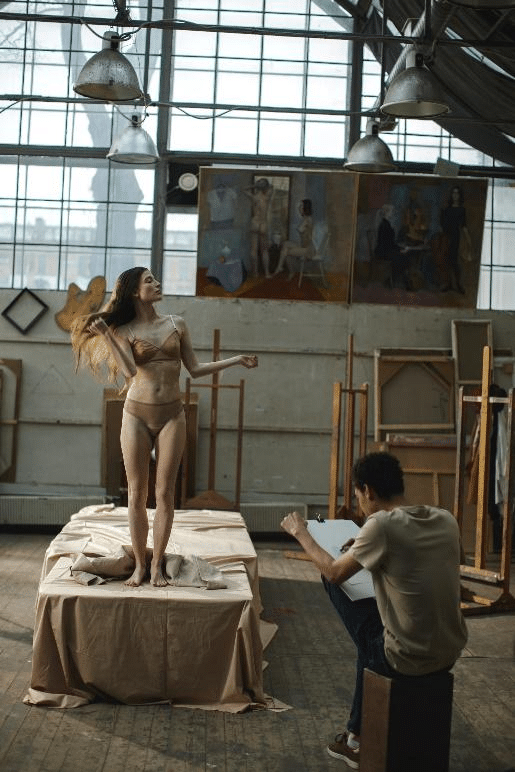
Este ejemplo de dibujo de modelo vivo muestra cómo con unas pocas líneas se puede capturar la esencia y el movimiento de una pose. Observa cómo el artista se ha enfocado en las curvas principales del cuerpo y en la tensión de los músculos, creando una imagen dinámica y expresiva con economía de trazos.
¿Ansioso por mejorar tus habilidades de dibujo de figura? Ingresa aquí para perfeccionar el arte del dibujo de modelo vivo y descubre técnicas avanzadas para capturar la esencia del movimiento en tus ilustraciones.
Maniquíes: Tu compañero de práctica disponible 24/7
Aunque nada supera la experiencia de dibujar un modelo vivo, los maniquíes ofrecen una alternativa práctica y accesible para mejorar tus habilidades en la creación de poses expresivas. Sin embargo, no todos los maniquíes son iguales, y elegir el adecuado puede marcar una gran diferencia en tu aprendizaje.
El clásico maniquí de madera, aunque icónico, tiene limitaciones significativas en términos de realismo anatómico y rango de movimiento. Para un estudio más efectivo, busca maniquíes modernos que ofrezcan:
- Mayor articulación y rango de movimiento
- Proporciones anatómicas más precisas
- Detalles musculares y óseos visibles
- Capacidad para mantener poses complejas
En la era digital, también tienes a tu disposición una amplia gama de maniquíes virtuales 3D. Estos pueden encontrarse en:
- Aplicaciones móviles especializadas en poses para artistas
- Software de dibujo como CLIP STUDIO, que incluye modelos 3D integrados
- Plataformas en línea que ofrecen bibliotecas de poses personalizables
Las ventajas de los maniquíes virtuales incluyen:
- Posibilidad de rotar y ajustar la pose desde cualquier ángulo
- Opciones de iluminación para estudiar sombras y volúmenes
- Capacidad de guardar y reutilizar poses personalizadas
- Acceso a una variedad infinita de poses sin limitaciones físicas
Sin embargo, recuerda que los maniquíes, tanto físicos como virtuales, son herramientas de estudio y no deben reemplazar completamente la observación del mundo real. Úsalos como complemento para:
- Practicar ángulos difíciles
- Entender mejor la mecánica del cuerpo humano
- Experimentar con poses extremas o dinámicas
- Mantener tu práctica constante cuando no tienes acceso a modelos vivos
¿Listo para explorar el potencial de los maniquíes en tu arte? Descubre aquí cómo integrarlos efectivamente en tu proceso creativo y aprende técnicas avanzadas para crear poses dinámicas y expresivas utilizando estas versátiles herramientas.
Inspiración en movimiento: El arte y el deporte como maestros de la expresión corporal
Para elevar verdaderamente nuestras habilidades en la creación de poses expresivas, debemos mirar más allá del mundo del dibujo y la ilustración. Las artes escénicas y los deportes ofrecen una fuente inagotable de inspiración, mostrando el cuerpo humano en su máxima expresión de movimiento y emoción.
El teatro y la danza: Maestros de la emoción corporal
El teatro y la danza son disciplinas que han perfeccionado el arte de comunicar emociones y narrativas a través del cuerpo. Observar estas formas de arte puede enseñarnos:
- Cómo el cuerpo entero participa en la expresión de una emoción
- La importancia de la tensión y relajación en diferentes partes del cuerpo
- Cómo pequeños gestos pueden transmitir grandes sentimientos
- La fluidez y continuidad del movimiento en secuencias complejas
Consejos para aprender de las artes escénicas:
- Asiste a obras de teatro y espectáculos de danza, enfocándote en el lenguaje corporal de los artistas.
- Estudia fotografías o videos de performances, pausando en momentos clave para analizar las poses.
- Practica dibujando rápidos bocetos durante los ensayos, si tienes la oportunidad.
- Experimenta con poses dramáticas frente a un espejo, sintiendo cómo tu cuerpo expresa diferentes emociones.
El deporte: La expresión del cuerpo en su límite
Los deportes, especialmente aquellos que requieren gran destreza física, nos muestran el cuerpo humano operando en sus límites. Observar atletas en acción nos enseña:
- La mecánica del cuerpo bajo estrés y en movimientos extremos
- Cómo se distribuye la tensión a través de los músculos en diferentes acciones
- La belleza de la forma humana en movimientos precisos y controlados
- La variedad de poses dinámicas que el cuerpo puede adoptar
Cómo aprovechar el deporte para mejorar tus poses:
- Observa eventos deportivos en vivo o grabados, prestando atención a los momentos de máxima acción.
- Estudia fotografías deportivas de alta velocidad, que capturan momentos imposibles de ver a simple vista.
- Practica dibujando atletas en movimiento, enfocándote en capturar la energía y la dirección del movimientomás que en los detalles precisos.
- Experimenta con diferentes deportes para ampliar tu repertorio de poses dinámicas.
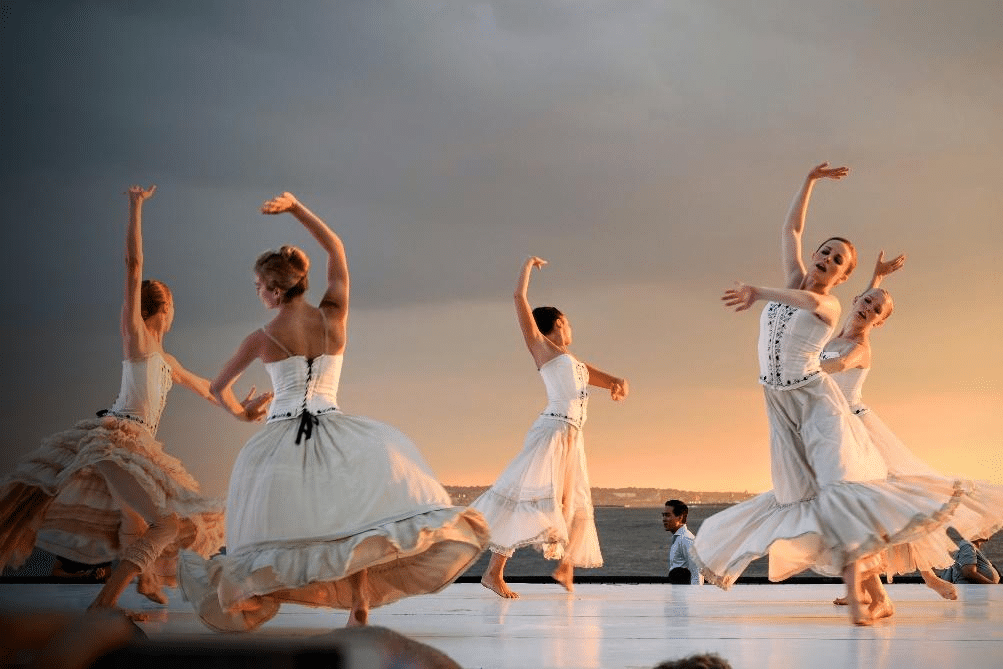
Esta imagen de bailarines en pleno movimiento ilustra perfectamente cómo el cuerpo humano puede adoptar poses increíblemente expresivas y dinámicas. Observa la tensión en los músculos, la extensión de las extremidades y la forma en que cada parte del cuerpo contribuye a la expresión global del movimiento. Estas son las cualidades que queremos capturar en nuestras ilustraciones para darles vida y emoción.
¿Ansioso por llevar la expresividad de tus personajes al máximo? Descubre aquí cómo incorporar la dinámica del deporte y la danza en tus ilustraciones y aprende a crear poses que capturen la esencia del movimiento y la emoción humana.
Conclusión: El camino hacia la maestría en poses expresivas
Dominar el arte de las poses expresivas es un viaje continuo de observación, práctica y experimentación. A lo largo de este artículo, hemos explorado diversas técnicas y fuentes de inspiración para enriquecer tu repertorio de poses y dar vida a tus personajes:
- Aprendimos a evitar la rigidez estudiando las sutilezas del movimiento natural del cuerpo.
- Descubrimos cómo utilizar la fotografía de manera efectiva para capturar la autenticidad de las poses.
- Exploramos el invaluable ejercicio del dibujo de modelo vivo para desarrollar nuestra percepción y habilidades.
- Consideramos el uso de maniquíes, tanto físicos como digitales, como herramientas de práctica constante.
- Nos inspiramos en las artes escénicas y los deportes para ampliar nuestra comprensión de la expresión corporal.
Recuerda que la clave para lograr poses verdaderamente expresivas radica en la observación constante del mundo que te rodea. Cada persona que ves en la calle, cada atleta en la televisión, cada bailarín en un escenario, es una lección potencial en expresión corporal.
La práctica regular es fundamental. Dedica tiempo cada día a esbozar poses rápidas, experimentar con diferentes técnicas y desafiar tus habilidades. No temas salir de tu zona de confort y probar nuevas aproximaciones a la figura humana.
Finalmente, recuerda que la expresividad no solo se trata de la pose en sí, sino de la emoción y la historia que transmite. Busca siempre infundir vida y propósito en cada línea que dibujas.
¿Estás listo para revolucionar tus habilidades de ilustración? Da el siguiente paso en tu viaje artístico aquí y descubre cómo puedes llevar tus poses expresivas al siguiente nivel, creando personajes que no solo se vean bien, sino que cuenten historias impactantes con cada gesto y movimiento.
El mundo de las poses expresivas es vasto y emocionante. Con dedicación, práctica y una mirada atenta al mundo que te rodea, podrás crear ilustraciones que no solo capten la atención, sino que también toquen el corazón de tu audiencia. ¡El lienzo está en blanco y las posibilidades son infinitas! ¿Qué historia contarás con tu próxima pose?



